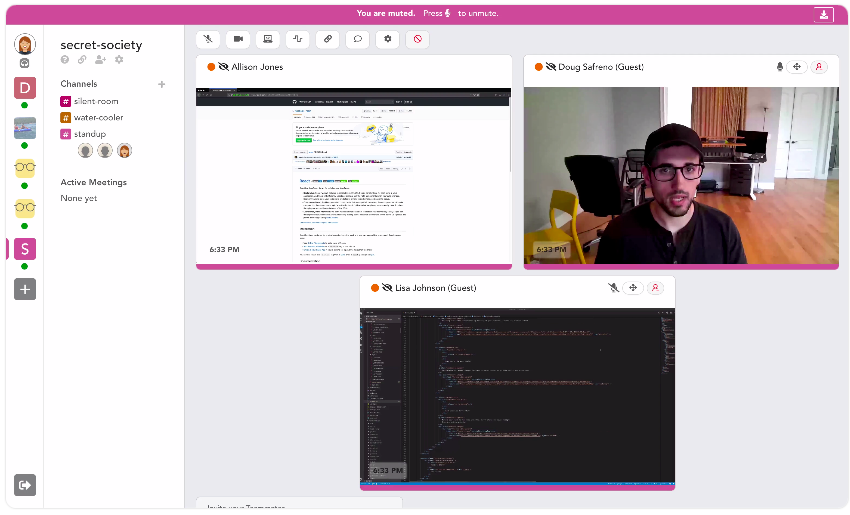Pragli's Here to Help Remote Teams Foster In-Person Connection, Digitally
An overview of the Pragli dashboard
Remote teams have the fun, yet creative task for reinventing what the “traditional” office set up looks like for their dispersed team.
Slack, Zoom, Hangouts, Asana tables, and Facetime . . . the tools of the trade piece together a virtual office environment to replicate the communication and connection one would have in a physical office. But it does take the right people and the right use of the tools to keep a remote team feeling truly connected.
Enter Pragli, a remote team’s digital space and communication platform that helps teammates see one another’s avatars in real time. Listening to Spotify? On a call with a teammate? Your avatar will reflect it and shift around so you feel like you’re seeing your coworkers right with you in your home office, coworking space, or cafe where you’re sitting and focusing.
Pragli co-founders Doug and Vivek developed the platform two years ago, after remote working themselves. While they loved it, they were frustrated about the loneliness and communication overhead. They sought to solve those problems with Pragli.
We chatted with co-founder Doug who walked us through Pragli and gave us some advice for remote workers out there today, who might be new to telecommuting with their team at this time.
Hi Doug! Can you tell us about yourself? And Pragli’s other co-founder, Vivek?
I’m currently working out of a coffee shop in Hilo on the big island of Hawaii. I’m based in San Francisco but take advantage of a remote lifestyle. My co-founder, Vivek, is also based in San Francisco but spends a lot of time in Washington D.C. and southern California.
Pragli co-founders Vivek and Doug
What’s the story behind starting Pragli?
Vivek and I had previously built and sold a company together. We lived in San Francisco, and we were working at the acquiring company in Santa Clara. Eventually, we ended up spending most days working from home rather than doing the 90 minutes each way to the office.
Once we started working remotely, we realized that we loved it and would have a hard time going back. That being said, we also realized that there were a couple limitations.
The first was that it was much harder to quickly resolve issues and get help or feedback when working remotely than in the office.
The second was that we didn’t bond as much with our teammates from home. In fact, we started feeling pretty lonely.
It turned out that we weren’t the only ones who were experiencing these issues. Buffer and AngelList’s State of Remote Work 2020 found that the top two reported issues amongst remote workers are communication, collaboration, and loneliness.
We decided to build Pragli to solve these problems by bringing the best parts of an office online.
What types of teams (work/industry) are using Pragli now?
Most of our teams are entire startups or development teams within larger tech organizations. That being said, I believe any remote team with significant collaboration would benefit from Pragli.
What do you see as the most common issues remote teams struggle with? And how does Pragli help with that?
The most common issues that remote teams struggle with are communication and loneliness. Here’s how Pragli can help.
Communication
Pragli helps reduce communication friction by solving the Slack Teams "back-and-forth" problem. You've probably experienced it before:
You message someone
After 2 minutes, they get back to you
You ask for clarification
They reply
Before you know it, 15 minutes have gone by typing away to figure something out that could've been done in person in 2 minutes. 50+ messages later, you decide to schedule a time to talk it out for the next day. You context switch onto some other work in the interim.
This is a communication disaster.
Instead, in Pragli, you can see if someone's available and, if so, immediately talk it out in channels (virtual conference rooms) or via a direct conversation. Both mediums support audio, video, screen share (including multiple people at once), celebrations, and many other forms of rich collaboration.
Loneliness
Teammates don’t naturally become as close remotely. Pragli solves this in several ways:
Spaces for not working- this includes via dedicated channels like the #water-cooler, as well as via our built-in trivia game.
Self-expression- teammates express themselves with live avatars in Pragli. These passively provide a sense of a team that’s working together. They also give teammates a way to express themselves.
View of your teammate’s avatars on Pragli
Higher-fidelity communication- teammates communicate with audio/video first in Pragli, so they are able to get more personal than over text.
Celebrations- Pragli channels and direct communications both feature celebrations, a fun way to recognize your teammates for the work they done.
How do you think remote teams are changing up the future of work?
Remote work has been the future for a long time. People are tired of commuting to an office so that they can Slack the person sitting next to them with headphones on. They demand control over their time and lifestyle.
Sadly, COVID-19 / coronavirus has created the world’s first remote work experiment. I believe that most teams who start working remotely because of the virus will go back in the office once it has passed. However, it’s bringing the benefits of remote work to the forefront of a lot of peoples’ brains, and I do expect to see accelerated long-term adoption of remote work.
When teams go remote, certain work habits change.
Time zones: this only applies to certain teams, as some remote teams operate in the same time zone or at least the same continent. For those teams that are global, time zones become a real mess to work around. Asynchronous communication is a must, as is getting in some face time to build closeness.
Status: in an office, it’s pretty easy to see who is available and who is not. In a remote team, you don’t know. This discourages communication.
Time Efficiency: remote teams have a bigger day since they don’t need to commute. They gain more hours which they can split between work and life, or they can allocate to just one or the other. In addition, remote teams often have less distraction (though some home situations can be distracting). Productivity often increases.
Text: Many teams switch to text-only communication. We believe this is bad because it causes communication friction and loneliness, which is why we recommend using a virtual office like Pragli.
While remote teams do share some similarities, they also operate differently from one another. As an example, a global, fully distributed team operates very differently from a hybrid, continental remote team. I recently wrote a post about the 6 categories of remote teams that I encourage you to read for more nuance on the subject.
Any nifty examples of how teams have been using Pragli? Any favorite components of Pragi?
Teams generally use Pragli in two ways:
As a full virtual office, where everyone is expected to be online as much as possible when working (works better for continental teams)
As a digital coworking space, where everyone coworks a few hours a week (works better for global teams)
A few surprises that we’ve had were:
Avatars - people love avatars. We frequently have managers rave about how their normally introverted teammate expressed themselves and interacted much more strongly with the team via their avatar.
Out-of-band “work” - some teammates will create separate Pragli teams for just themselves and a few work friends. Maybe they’re not working? Maybe they are just hanging out? Hard for us to tell.
What’s the most surprising lesson you’ve learned as a founder? Also was being a founder always a goal?
Being a founder was not always the goal. Our first company came out of our Stanford coursework. We were lucky to be encouraged by a professor to turn it into a company, and we said yes. After doing it once, we knew we weren’t going back.
The biggest lesson I’ve learned is: it’s all about the market. Vivek and I spent months interviewing remote workers before starting work on Pragli to gauge that the need for this was there.
The most surprising: grinding only takes you so far. I believe good founders take time to step back and think critically about their business and run experiments. My rule of thumb would be at least 20 percent of your time should not be spent implementing your current roadmap but should be instead be spent on fun experiments.
How has Pragli changed from idea to today’s iteration?
Quite a bit! Pragli initially had everyone’s video on all the time, but we switched to live avatars because it felt too invasive. We’ve also added channels, a calendar integration, statuses, and many more features.
How would you say Pragli is different from a team using any other communication structure to keep up-to-date and connected with one another?
Most teams are using text, like Slack or Teams, plus conferencing via Zoom or WebEx. Pragli encourages you to use your text service asynchronously, and to speak synchronously with one another in Pragli itself. Speaking rather than typing has a number of benefits, including being faster and building closeness.
What’s on the horizon for you and for Pragli?
Immediately, a browser extension, mobile support, and better support for very large teams. There’s much more beyond that!



